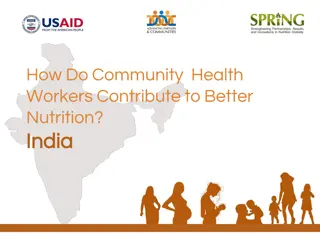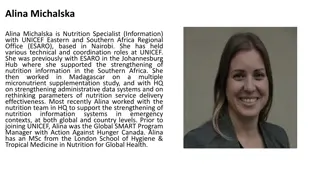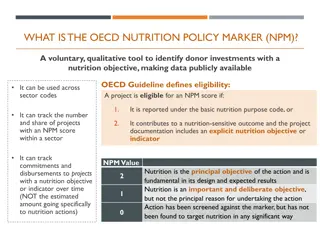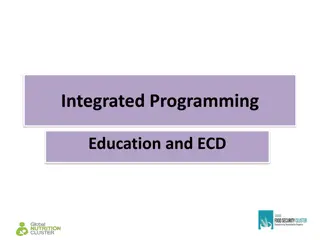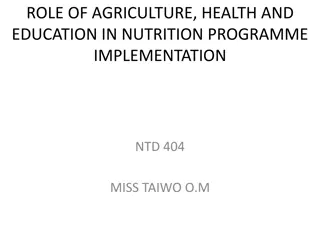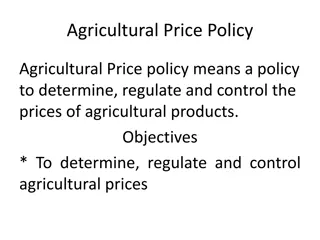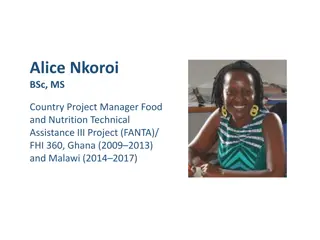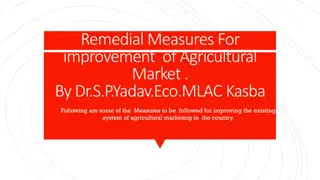
Agricultural Development and Nutrition Improvement: India, Africa, and Beyond
This presentation delves into the comparative perspectives of agricultural development and nutrition improvement in India, Africa, and other regions. It focuses on common development paths, rural demography, nutritional outcomes, technological changes, and disparities in food supply and real income. The analysis involves child heights and weights, poverty rates, and the progress made in alleviating impoverishment in different regions over time.
Download Presentation

Please find below an Image/Link to download the presentation.
The content on the website is provided AS IS for your information and personal use only. It may not be sold, licensed, or shared on other websites without obtaining consent from the author. If you encounter any issues during the download, it is possible that the publisher has removed the file from their server.
You are allowed to download the files provided on this website for personal or commercial use, subject to the condition that they are used lawfully. All files are the property of their respective owners.
The content on the website is provided AS IS for your information and personal use only. It may not be sold, licensed, or shared on other websites without obtaining consent from the author.
E N D
Presentation Transcript
Agricultural development and nutrition improvement in comparative perspective: India, Africa and the rest William A. Masters Professor, Friedman School of Nutrition Science and Policy, Tufts University http://sites.tufts.edu/willmasters with Amelia F. Darrouzet-Nardi Doctoral Candidate, Friedman School of Nutrition Science and Policy, Tufts University http://sites.tufts.edu/ameliadarrouzetnardi IEG-IFPRI Conference on Innovations in Indian Agriculture New Delhi, 4-5 December 2014
Agricultural development & nutrition improvement in comparative perspective: India, Africa and the rest What s ahead: Agricultural development Common development paths? Rural demography and age structure Nutritional improvement Comparable data by region over time? Heights and weights Conclusions Confounders and randomness Implications for agricultural innovation
Agricultural development & nutrition improvement Agricultural develop. | child heights | child weights Nutrition outcomes Are there common development paths? Nutrition Agriculture Technological change
Agricultural development & nutrition improvement Agricultural develop. | child heights | child weights Common development paths? Food supply and real income by region, 1990-2012 3500 Dietary energy (kCal/pers/day) High-Income Countries 3000 World Average 2500 What s behind this Asia-Africa difference? South Asia Sub-Saharan Africa 2000 0 10,000 Real income per capita (GDP at 2011 PPP prices) 20,000 30,000 40,000 50,000 Source: Author s calculations, May 2014. Real income is from World Bank, World Development Indicators (April 2014), downloaded from http://data.worldbank.org. Food supply is from FAO, Food Security Indicators (December 2013), downloaded from http://www.fao.org/economic/ess/ess-fs. Each point is a 3-year average, from 1990-92 to 2010-12.
Agricultural development & nutrition improvement Agricultural develop. | child heights | child weights Africa s impoverishment is relatively recent Only in the 1990s did they get as poor as S. Asian farmers had been Poverty rates by region, 1981-2010 (share of population below $1.25/day) 80 East Asia South Asia Sub-S. Africa Rest of World 70 60 50 40 30 20 10 0 1981 1984 1987 1990 1993 1996 1999 2002 2005 2008 2010 Source: Author s calculation from World Bank (2013), PovcalNet (http://iresearch.worldbank.org/PovcalNet/), updated 18 April 2013. Estimates are based on over 850 household surveys from 127 countries, and refer to per-capita expenditure at purchasing-power parity prices for 2005.
Agricultural development & nutrition improvement Agricultural develop. | child heights | child weights Africa faces more rural population growth than India Africa s rural demographic transition is 20 years behind South Asia s Rural population increase in Africa, South Asia and Worldwide, 1950-2050 Annual change in rural population (% growth) 2.5 1990-2014 2.0 1.5 1.0 0.5 0.0 SS Africa -0.5 For the world as a whole, rural population growth will soon become negative, allowing more land per farm World -1.0 So Asia -1.5 Source: Calculated from UN Population Division, World Population Projections (http://esa.un.org/unpd/wpp), based on UN Population Prospects: The 2010 Revision and World Urbanization Prospects: The 2011 Revision.
Agricultural development & nutrition improvement Agricultural develop. | child heights | child weights Africa faces much more child dependency than India Africa s rural demographic transition is 20 years behind South Asia s Child and elderly dependency rates by region (0-15 and 65+), 1950-2030 Children or elderly per 100 adults of working age (16-65) 80 100 Africa s dependency rate is still high but now falling, reversing the earlier demographic drag 1990-2014 90 World 70 SSAfrica SoAsia 60 50 40 19501960197019801990200020102020203020402050 Source: Calculated from UN Population Division, World Population Projections (http://esa.un.org/unpd/wpp), based on UN Population Prospects: The 2010 Revision and World Urbanization Prospects: The 2011 Revision.
Agricultural development & nutrition improvement Agricultural develop. | child heights | child weights What is known about nutrition improvement? Heights and weights Some anthropological and other records 18th & 19th c. data on military recruits Modern surveys of mothers & children Nutritional inputs Diets (foods, nutrients and anti-nutrients) Care (breastfeeding, disease & treatment) Parents (genes, epigenetics & maternal health) Nutritional status Anthropometry (heights, weights, body size) Biomarkers (blood, urine, body composition)
Agricultural development & nutrition improvement Agricultural develop. | child heights | child weights What is known about rural nutrition improvement? Oldest and newest DHS surveys in S. Asia, Africa & the Rest Survey year First # of subnat. reg. First Elapsed years Region and Country South Asia India Bangladesh Nepal S.Asia average Africa average RoW average . Worldwide average Note: Inclusion criterion is availability of both HAZ and WHZ data for children with rural residence. Last Last 1992 1996 2001 1996 1995 1995 2005 2011 2011 2009 2008 2005 13 15 10 20 29 6 5 7 3 12.7 13.7 10.0 10.3 6.4 9.1 13.0 10.2 10.5 1995 2007 12.5 7.6 10.5
Agricultural development & nutrition improvement Agricultural develop. | child heights | child weights Child heights rose slightly from 1992 to 2005 in India Mean HAZ of rural children by subnational region at each national income level in oldest and newest DHS surveys (oldest = Os & dashed line, newest = squares & solid line, India is green Xs) 0 Mean HAZ at each level of national income -.5 -1 -1.5 -2 -2.5 5.5 6 6.5 7 7.5 8 8.5 9 Log of country's national real GDP per capita at PPP prices (2005 USD), from PWT 8.0 Note: Worldwide means and confidence intervals are estimated by lpolyci, with a bandwidth of 0.75. Sample is all rural children with both heights and weights in repeated DHS surveys from 33 countries for 112,730 obs. in the oldest surveys (1987-2006) and 142,677 in the newest (2000-2011). Data shown are subnational administrative regions; India surveys are in 1992 and 2005.
Agricultural development & nutrition improvement Agricultural develop. | child heights | child weights Africans are now poorer but often taller than Indians Mean HAZ of rural children at each national income level, by the newest (squares) and oldest (Os) DHS survey (Africa in blue, South Asia in green, Rest-of-World in red, India is green Xs 0 Mean HAZ at each level of national income -.5 -1 -1.5 -2 -2.5 5.5 6 6.5 7 7.5 8 8.5 9 Log of real GDP per capita at PPP prices (2005 USD), from PWT 8.0 Note: Worldwide means and confidence intervals are estimated by lpolyci, with a bandwidth of 0.75, with most recent surveys shown in the solid line and the oldest survey in the dashed line. Data shown are subnational regions in India, Nepal and Pakistan plus 20 in Africa and 10 elsewhere.
Agricultural development & nutrition improvement Agricultural develop. | child heights | child weights Stunting rates follow mean height but vary more Stunting rates of rural children at each national income level, by the newest (squares) and oldest (Os) DHS survey (subnational regions in Africa in blue, South Asia in green, Rest-of-World in red, India is green Xs) Stunting rate by subnational region (% of children with HAZ < -2) 60 40 20 0 5.5 6 6.5 7 7.5 8 8.5 9 Log of real GDP per capita at PPP prices (2005 USD), from PWT 8.0 Note: Worldwide means and confidence intervals are estimated by lpolyci, with a bandwidth of 0.75, with most recent surveys shown in the solid line and the oldest survey in the dashed line. Data shown are subnational regions in India, Nepal and Pakistan plus 20 in Africa and 10 elsewhere.
Agricultural development & nutrition improvement Agricultural develop. | child heights | child weights India s wasting rates worsened from 1992 to 2005 Wasting rates of rural children at each national income level, by the newest (squares) and oldest (Os) DHS survey (subnational regions in Africa in blue, South Asia in green, Rest-of-World in red, India is green Xs) Wasting rate by subnational region (% of children with HAZ < -2) 40 30 20 10 0 5.5 6 6.5 7 7.5 8 8.5 9 Log of real GDP per capita at PPP prices (2005 USD), from PWT 8.0 Note: Worldwide means and confidence intervals are estimated by lpolyci, with a bandwidth of 0.75, with most recent surveys shown in the solid line and the oldest survey in the dashed line. Data shown are subnational regions in India, Nepal and Pakistan plus 20 in Africa and 10 elsewhere.
Agricultural development & nutrition improvement Agricultural develop. | child heights | child weights Mean weight-for-height follows wasting & varies less Mean WHZ of rural children at each national income level, by the newest (squares) and oldest (Os) DHS survey (Africa in blue, South Asia in green, Rest-of-World in red, India is green Xs 2 Mean WHZ at each level of national income 1 0 -1 -2 5.5 6 6.5 7 7.5 8 8.5 9 Log of real GDP per capita at PPP prices (2005 USD), from PWT 8.0 Note: Worldwide means and confidence intervals are estimated by lpolyci, with a bandwidth of 0.75, with most recent surveys shown in the solid line and the oldest survey in the dashed line. Data shown are subnational regions in India, Nepal and Pakistan plus 20 in Africa and 10 elsewhere.
Agricultural development & nutrition improvement Agricultural develop. | child heights | child weights In conclusion Nutrition improvement varies widely Local confounders modify agriculture s effects -- e.g. poor sanitation alters impact of diets Lots of randomness makes effects hard to see -- need large sample sizes, expensive surveys Implications for agriculture are still unclear Agriculture has many different effects on nutrition --- e.g. diet diversity, seasonality, caregivers time use But so do non-agricultural factors -- e.g. impact of mother and grandmother s health today s children echo nutrition of the 1970s Success calls for patience and realism as well as ambition
Agricultural development & nutrition improvement Agricultural develop. | child heights | child weights Thank you! The analysis presented here builds on work with Amelia F. Darrouzet-Nardi, especially Urbanization, market development and malnutrition in farm households: Evidence from the Demographic and Health Surveys, 1990-2011. (forthcoming 2015). For other background papers: -- http://sites.tufts.edu/willmasters For school info: -- http://nutrition.tufts.edu
Agricultural development & nutrition improvement Agricultural develop. | child heights | child weights The full set of first & last DHS surveys shown here Countries, years and number of subnational regions in the long-difference panel of DHS surveys Year N (subnat. reg.) First Year First N (subnat. reg.) First Elapsed time Elapsed time Region and Country South Asia Bangladesh India Nepal S. Asia average First Last Last Region and Country Africa Burkina Faso Benin Cameroon Ethiopia Ghana Guinea Kenya Lesotho Madagascar Mali Malawi Mozambique Nigeria Niger Namibia Rwanda Senegal Tanzania Uganda Zimbabwe Africa average Last Last 1996 1992 2001 1996 2011 2005 2011 2009 15 13 10 6 7 1993 1996 1991 2000 1993 1999 1993 2004 1992 1995 1992 1987 1990 1992 1992 1992 1992 1991 2006 2005 1995 2010 2006 2011 2011 2008 2005 2008 2009 2003 2006 2010 2011 2008 2006 2006 2010 2010 2010 2011 2010 2008 17 10 20 11 15 5 6 5 13 12 12 11 10 20 29 5 3 12.7 10.3 13.0 11 10 6 5 7 8 8 Rest-of-World Armenia Turkey Bolivia Colombia DR Peru Egypt Jordan Morocco Cambodia RoW average 15 2000 1998 1994 1995 1991 1996 1995 1990 1992 2000 1995 2010 2003 2008 2005 2007 2000 2008 2002 2003 2005 2005 10 11 11 5 10 10 5 5 7 5 8 5 9 6 8 11 11 18 24 18 14 14 18 18 19 6 6 3 6 9 3 14 10 16 11 11 4 24 24 4 4 2 5 4 5 9 6 8 13 12 11 2 5 7 2 3 13 15 22 11 4 5 17 14 26 10 10 10 9 5 5 10 6.4 Worldwide average 1995 2007 12.5 7.6 10.5 13.7 10.2 Note: Inclusion criterion is availability of both HAZ and WHZ data for children with rural residence.



